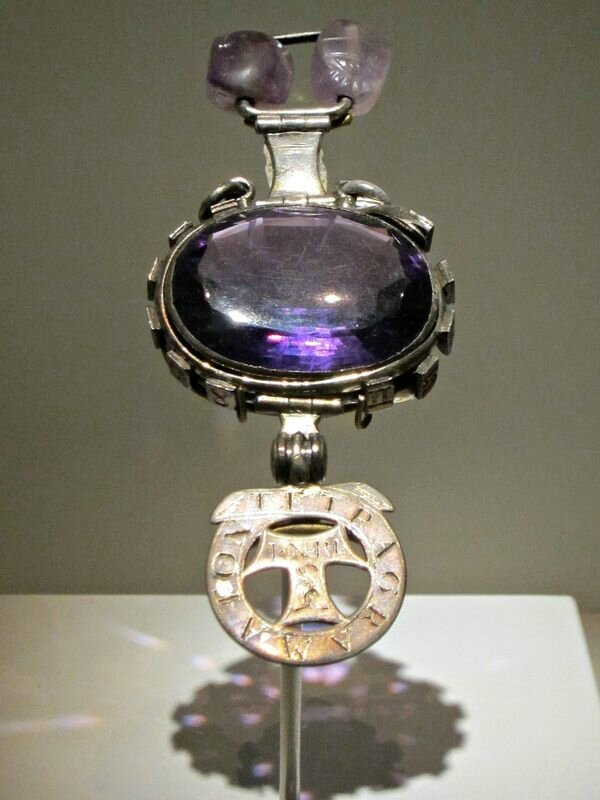The Delhi Purple Sapphire or The Cursed Amethyst
The Delhi Purple Sapphire.
The fascinating story of the Delhi Purple Sapphire is one that was virtually unknown until fairly recently, when a curious young curator at London’s Natural History Museum stumbled upon a type written note which was stored with the gemstone. The stone itself was not particularly remarkable. It was set in a rather unattractive silver ring and decorated with mysterious alchemical and astrological signs. However, the strange note began to unravel the gem's enthralling journey, and a dark tale of a curse and its victims.
Purple sapphires are an often misunderstood and underappreciated gem. They are actually quite extraordinary and far rarer than the more traditionally recognised blue sapphires. Unlike most blue and pink sapphires, which need to be heat treated in order to obtain their best color, purple sapphires very rarely require any heat treatment and are able to naturally change color in different lighting.
Sapphires are the non-red variety of corundum, (red corundum being ruby) and are traditionally given as wedding anniversary gifts during the 5th, 23rd and 45th years of marriage, with the star sapphire being given for the 65th year. Sapphires are also a pretty tough and durable gem, being the second hardest natural mineral with a score of 9 on the Mohs scale of hardness.
It is believed by some that sapphire carries the spiritual power of enlightenment and inner peace, and is even thought to hold healing properties for rheumatism and mental illness. However, despite its name, the Delhi Purple Sapphire is in fact an amethyst, and a gem that did not bring any benefits to its owners.
The earliest known whereabouts of the Delhi Purple Sapphire was thought to have been India, where it was looted from the Temple of Indra during the horrific Indian Mutiny of 1857. Ironically, the temple was devoted to the Hindu god of war and weather, and it is strongly believed that through its theft from the ancient idol, a curse was cast.
Photograph of a sculpture at the south end of the verandah of the Indra Sabha rock-cut temple at Ellora, from the Archaeological Survey of India Collections, taken by Henry Mack Nepean in 1868. The British Library
The Sapphire was brought to England by Colonel W. Ferris, a Bengal Cavalryman who would go on to regret taking the precious stone home with him. Soon after returning to England, the entire Ferris family seemed to be beset by health and financial trouble. They blamed their problems on a series of failed investments made by Mr. Ferris and his son, which left the family in near financial ruin. Things took a grave turn for the worse when a friend of the Ferris family unexpectedly committed suicide whilst in possession of the sapphire.
Edward Heron-Allen (via Wake Forest University Library)
Heron-Allen even claimed to have thrown the sapphire into the dark and dirty Regent's Canal, only for it to reappear in his possession some 3 months later after being found by a dredger. The jeweler who bought the gem from the dredger recognised the precious stone and returned it to Mr Heron-Allen, who was astonished and even more convinced that there was a powerful curse attached to it.
Finally in 1904, after the birth of his first daughter, and after some 14 years in possession of the Delhi Purple Sapphire, Heron-Allen sealed the gem inside a box and shipped it to his bankers with set instructions for it to be locked away until after his death.
Heron-Allen later bestowed the sapphire to the Natural History Museum, under the condition that the box was not to be opened until at least 3 years after his death, and that under no circumstances must his daughter ever touch or be in possession of it.
In 1943, after the death of Edward Heron-Allen, the Natural History Museum received the box containing the gem and put it to one side, as per his request. Sometime later, long after the box had been opened, a type written note was found, which detailed this somewhat chilling history.
Heron-Allen ended his note with these final words, "Whoever shall then open it, shall first read out this warning, and then do as he pleases with the jewel. My advice to him or her is to cast it into the sea".
In 2004 the gem was in the possession of John Whittaker, a member of the Natural History Museum who was tasked with transporting the purple sapphire to the Heron-Allen Society for an event. During the journey, Mr Whittaker and his wife were engulfed in a dramatic thunderstorm, which trapped them in their car. Mr Whittaker claimed it to be the most horrific experience of his life.
Whittaker was tasked with transporting the Sapphire a second time, after which he fell violently sick with a stomach bug, and then a third time, when just before he was due to take the gem he fell in pain, finally passing a kidney stone.
(Source GemSelect)
The Cursed Amethyst. (Image credit: Allison Meier)

/https%3A%2F%2Fprofilepics.canalblog.com%2Fprofilepics%2F1%2F0%2F100183.jpg)
/https%3A%2F%2Fstorage.canalblog.com%2F03%2F02%2F119589%2F96711876_o.jpg)
/https%3A%2F%2Fstorage.canalblog.com%2F11%2F31%2F119589%2F94773502_o.jpg)
/https%3A%2F%2Fstorage.canalblog.com%2F20%2F83%2F119589%2F94772815_o.jpg)
/https%3A%2F%2Fstorage.canalblog.com%2F26%2F72%2F119589%2F75604929_o.jpg)
/https%3A%2F%2Fstorage.canalblog.com%2F59%2F60%2F119589%2F26458628_o.jpg)






/image%2F1371349%2F20240425%2Fob_c453b7_439605604-1657274835042529-47869416345.jpg)
/image%2F1371349%2F20240425%2Fob_59c6f0_440358655-1657722021664477-71089985267.jpg)
/image%2F1371349%2F20240425%2Fob_07a28e_440353390-1657720444997968-29046181244.jpg)
/image%2F1371349%2F20240425%2Fob_0b83fb_440387817-1657715464998466-20094023921.jpg)